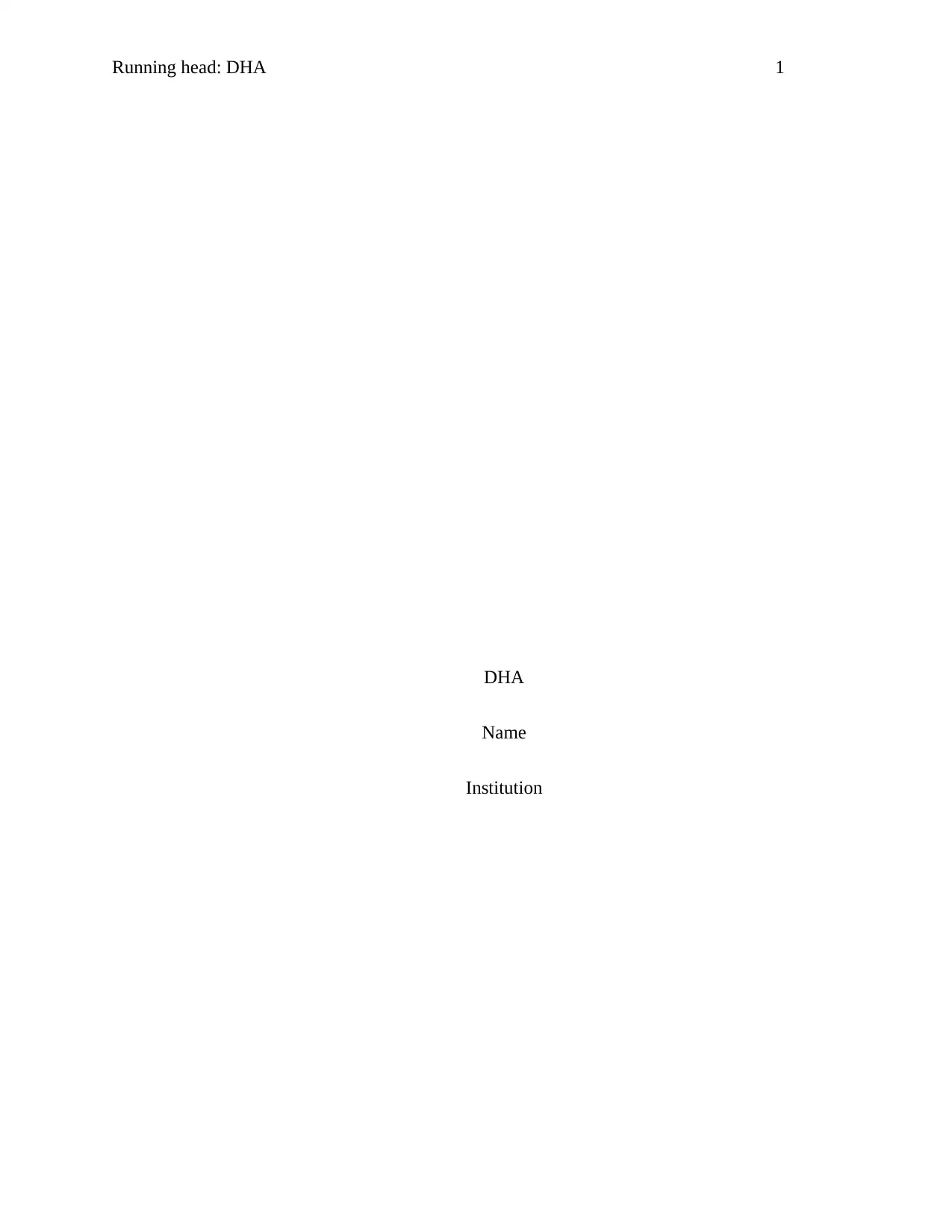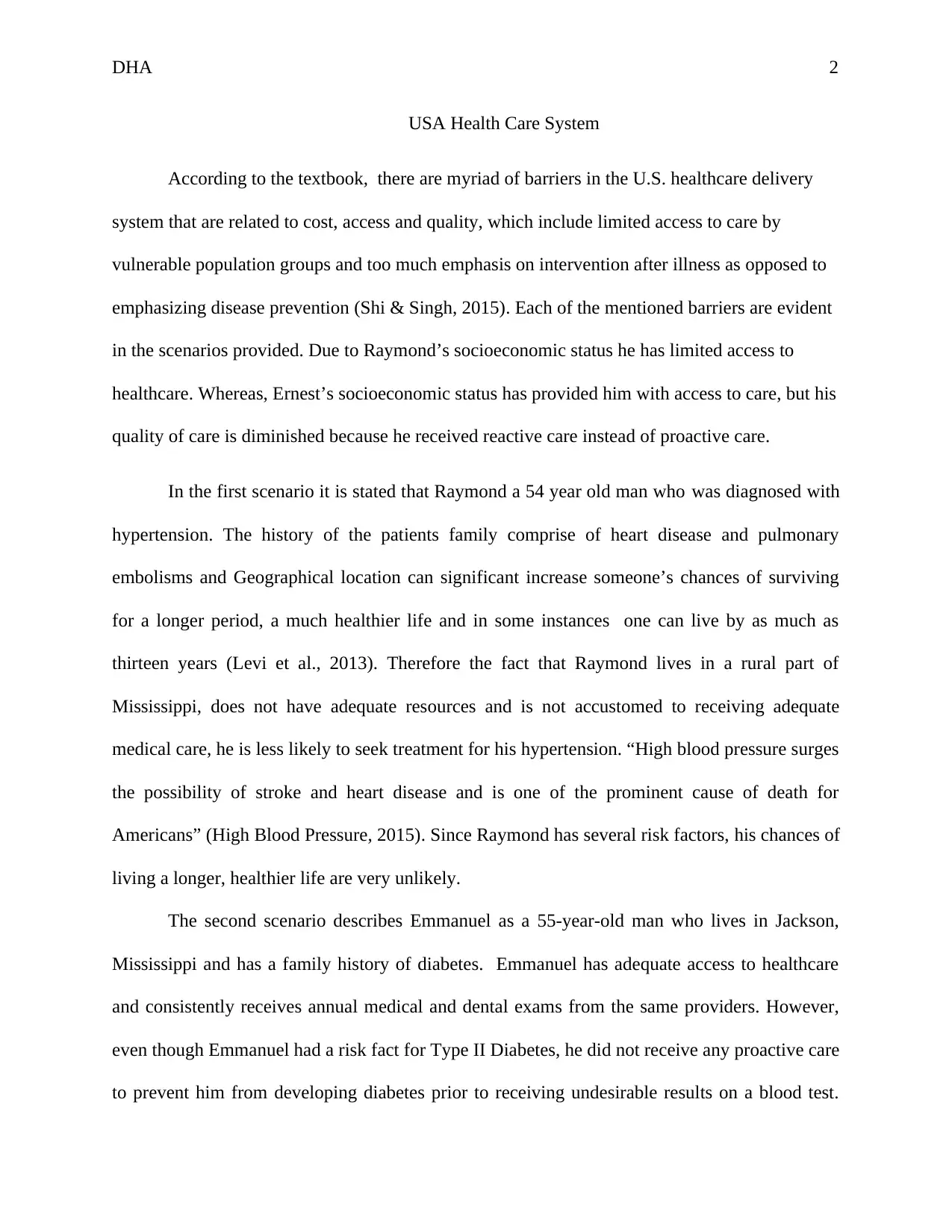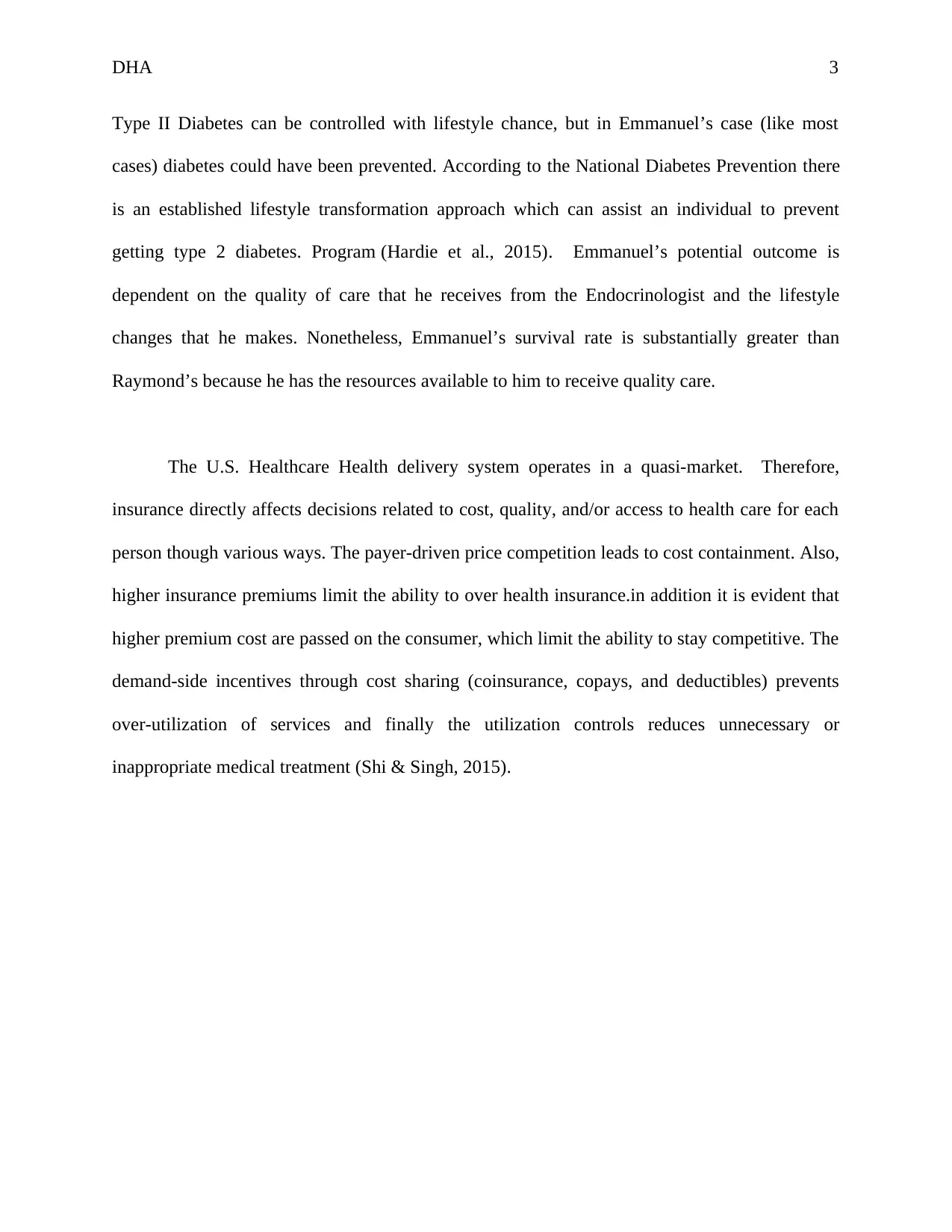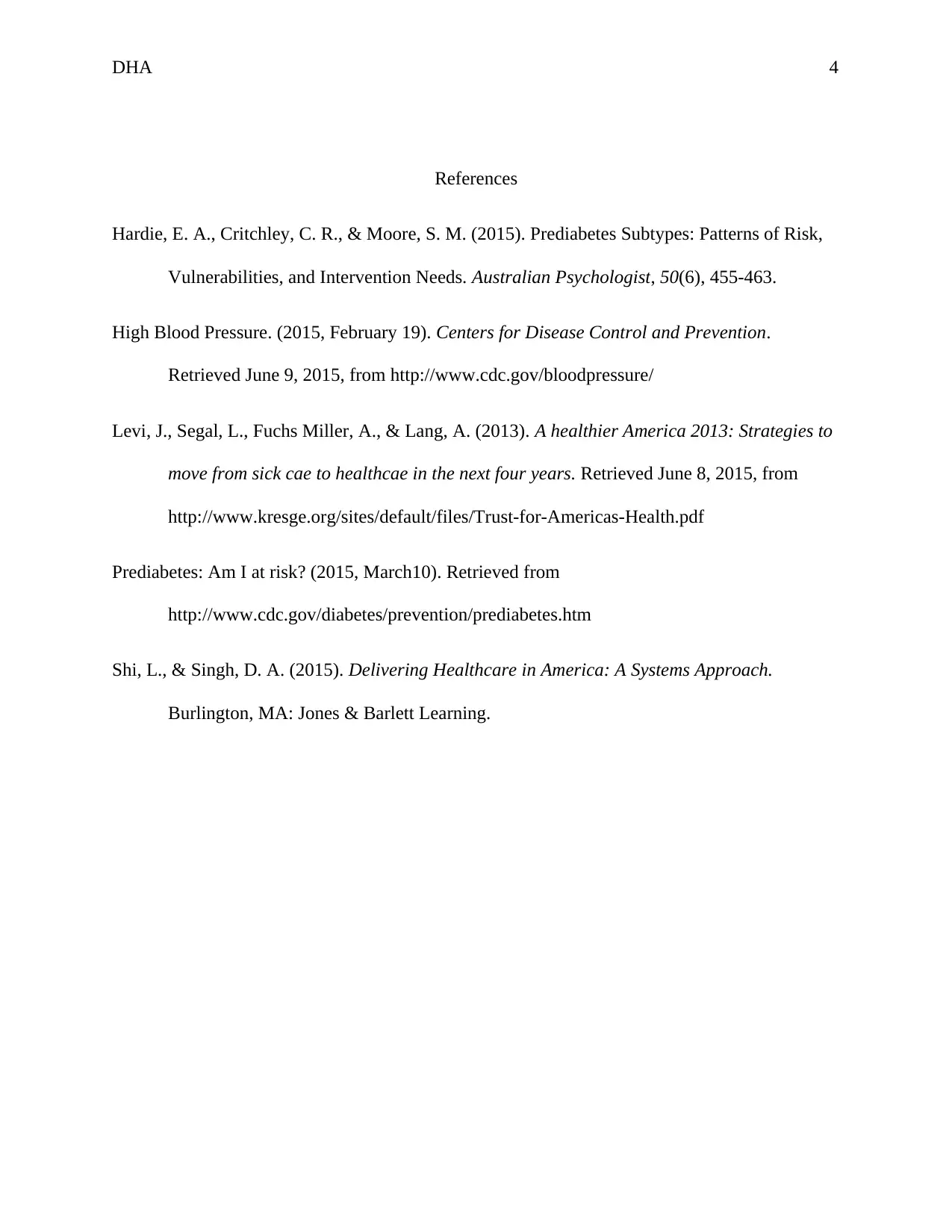DHA Case Study Analysis
VerifiedAdded on 2020/02/24
|4
|776
|38
Case Study
AI Summary
The DHA case study examines barriers in the U.S. healthcare system, focusing on socioeconomic factors affecting access and quality of care. It highlights two scenarios: Raymond, who faces limited access due to his rural location and socioeconomic status, and Emmanuel, who has better access but lacks proactive care for diabetes prevention. The analysis emphasizes the need for improved healthcare delivery and preventive measures to enhance health outcomes.

Running head: DHA 1
DHA
Name
Institution
DHA
Name
Institution
Paraphrase This Document
Need a fresh take? Get an instant paraphrase of this document with our AI Paraphraser

DHA 2
USA Health Care System
According to the textbook, there are myriad of barriers in the U.S. healthcare delivery
system that are related to cost, access and quality, which include limited access to care by
vulnerable population groups and too much emphasis on intervention after illness as opposed to
emphasizing disease prevention (Shi & Singh, 2015). Each of the mentioned barriers are evident
in the scenarios provided. Due to Raymond’s socioeconomic status he has limited access to
healthcare. Whereas, Ernest’s socioeconomic status has provided him with access to care, but his
quality of care is diminished because he received reactive care instead of proactive care.
In the first scenario it is stated that Raymond a 54 year old man who was diagnosed with
hypertension. The history of the patients family comprise of heart disease and pulmonary
embolisms and Geographical location can significant increase someone’s chances of surviving
for a longer period, a much healthier life and in some instances one can live by as much as
thirteen years (Levi et al., 2013). Therefore the fact that Raymond lives in a rural part of
Mississippi, does not have adequate resources and is not accustomed to receiving adequate
medical care, he is less likely to seek treatment for his hypertension. “High blood pressure surges
the possibility of stroke and heart disease and is one of the prominent cause of death for
Americans” (High Blood Pressure, 2015). Since Raymond has several risk factors, his chances of
living a longer, healthier life are very unlikely.
The second scenario describes Emmanuel as a 55-year-old man who lives in Jackson,
Mississippi and has a family history of diabetes. Emmanuel has adequate access to healthcare
and consistently receives annual medical and dental exams from the same providers. However,
even though Emmanuel had a risk fact for Type II Diabetes, he did not receive any proactive care
to prevent him from developing diabetes prior to receiving undesirable results on a blood test.
USA Health Care System
According to the textbook, there are myriad of barriers in the U.S. healthcare delivery
system that are related to cost, access and quality, which include limited access to care by
vulnerable population groups and too much emphasis on intervention after illness as opposed to
emphasizing disease prevention (Shi & Singh, 2015). Each of the mentioned barriers are evident
in the scenarios provided. Due to Raymond’s socioeconomic status he has limited access to
healthcare. Whereas, Ernest’s socioeconomic status has provided him with access to care, but his
quality of care is diminished because he received reactive care instead of proactive care.
In the first scenario it is stated that Raymond a 54 year old man who was diagnosed with
hypertension. The history of the patients family comprise of heart disease and pulmonary
embolisms and Geographical location can significant increase someone’s chances of surviving
for a longer period, a much healthier life and in some instances one can live by as much as
thirteen years (Levi et al., 2013). Therefore the fact that Raymond lives in a rural part of
Mississippi, does not have adequate resources and is not accustomed to receiving adequate
medical care, he is less likely to seek treatment for his hypertension. “High blood pressure surges
the possibility of stroke and heart disease and is one of the prominent cause of death for
Americans” (High Blood Pressure, 2015). Since Raymond has several risk factors, his chances of
living a longer, healthier life are very unlikely.
The second scenario describes Emmanuel as a 55-year-old man who lives in Jackson,
Mississippi and has a family history of diabetes. Emmanuel has adequate access to healthcare
and consistently receives annual medical and dental exams from the same providers. However,
even though Emmanuel had a risk fact for Type II Diabetes, he did not receive any proactive care
to prevent him from developing diabetes prior to receiving undesirable results on a blood test.

DHA 3
Type II Diabetes can be controlled with lifestyle chance, but in Emmanuel’s case (like most
cases) diabetes could have been prevented. According to the National Diabetes Prevention there
is an established lifestyle transformation approach which can assist an individual to prevent
getting type 2 diabetes. Program (Hardie et al., 2015). Emmanuel’s potential outcome is
dependent on the quality of care that he receives from the Endocrinologist and the lifestyle
changes that he makes. Nonetheless, Emmanuel’s survival rate is substantially greater than
Raymond’s because he has the resources available to him to receive quality care.
The U.S. Healthcare Health delivery system operates in a quasi-market. Therefore,
insurance directly affects decisions related to cost, quality, and/or access to health care for each
person though various ways. The payer-driven price competition leads to cost containment. Also,
higher insurance premiums limit the ability to over health insurance.in addition it is evident that
higher premium cost are passed on the consumer, which limit the ability to stay competitive. The
demand-side incentives through cost sharing (coinsurance, copays, and deductibles) prevents
over-utilization of services and finally the utilization controls reduces unnecessary or
inappropriate medical treatment (Shi & Singh, 2015).
Type II Diabetes can be controlled with lifestyle chance, but in Emmanuel’s case (like most
cases) diabetes could have been prevented. According to the National Diabetes Prevention there
is an established lifestyle transformation approach which can assist an individual to prevent
getting type 2 diabetes. Program (Hardie et al., 2015). Emmanuel’s potential outcome is
dependent on the quality of care that he receives from the Endocrinologist and the lifestyle
changes that he makes. Nonetheless, Emmanuel’s survival rate is substantially greater than
Raymond’s because he has the resources available to him to receive quality care.
The U.S. Healthcare Health delivery system operates in a quasi-market. Therefore,
insurance directly affects decisions related to cost, quality, and/or access to health care for each
person though various ways. The payer-driven price competition leads to cost containment. Also,
higher insurance premiums limit the ability to over health insurance.in addition it is evident that
higher premium cost are passed on the consumer, which limit the ability to stay competitive. The
demand-side incentives through cost sharing (coinsurance, copays, and deductibles) prevents
over-utilization of services and finally the utilization controls reduces unnecessary or
inappropriate medical treatment (Shi & Singh, 2015).
⊘ This is a preview!⊘
Do you want full access?
Subscribe today to unlock all pages.

Trusted by 1+ million students worldwide

DHA 4
References
Hardie, E. A., Critchley, C. R., & Moore, S. M. (2015). Prediabetes Subtypes: Patterns of Risk,
Vulnerabilities, and Intervention Needs. Australian Psychologist, 50(6), 455-463.
High Blood Pressure. (2015, February 19). Centers for Disease Control and Prevention.
Retrieved June 9, 2015, from http://www.cdc.gov/bloodpressure/
Levi, J., Segal, L., Fuchs Miller, A., & Lang, A. (2013). A healthier America 2013: Strategies to
move from sick cae to healthcae in the next four years. Retrieved June 8, 2015, from
http://www.kresge.org/sites/default/files/Trust-for-Americas-Health.pdf
Prediabetes: Am I at risk? (2015, March10). Retrieved from
http://www.cdc.gov/diabetes/prevention/prediabetes.htm
Shi, L., & Singh, D. A. (2015). Delivering Healthcare in America: A Systems Approach.
Burlington, MA: Jones & Barlett Learning.
References
Hardie, E. A., Critchley, C. R., & Moore, S. M. (2015). Prediabetes Subtypes: Patterns of Risk,
Vulnerabilities, and Intervention Needs. Australian Psychologist, 50(6), 455-463.
High Blood Pressure. (2015, February 19). Centers for Disease Control and Prevention.
Retrieved June 9, 2015, from http://www.cdc.gov/bloodpressure/
Levi, J., Segal, L., Fuchs Miller, A., & Lang, A. (2013). A healthier America 2013: Strategies to
move from sick cae to healthcae in the next four years. Retrieved June 8, 2015, from
http://www.kresge.org/sites/default/files/Trust-for-Americas-Health.pdf
Prediabetes: Am I at risk? (2015, March10). Retrieved from
http://www.cdc.gov/diabetes/prevention/prediabetes.htm
Shi, L., & Singh, D. A. (2015). Delivering Healthcare in America: A Systems Approach.
Burlington, MA: Jones & Barlett Learning.
1 out of 4
Your All-in-One AI-Powered Toolkit for Academic Success.
+13062052269
info@desklib.com
Available 24*7 on WhatsApp / Email
![[object Object]](/_next/static/media/star-bottom.7253800d.svg)
Unlock your academic potential
Copyright © 2020–2025 A2Z Services. All Rights Reserved. Developed and managed by ZUCOL.

